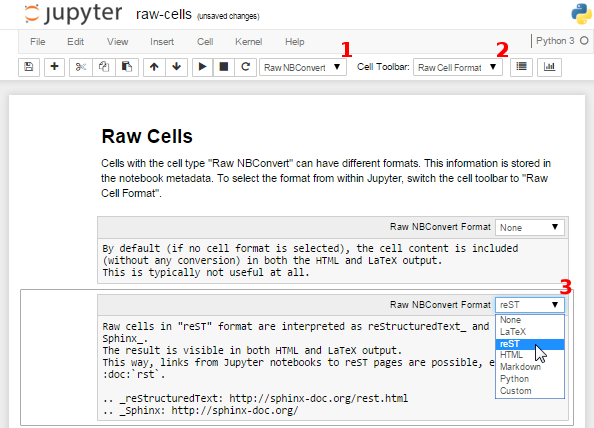It is possible to store Jupyter notebooks in plain Markdown. This allows youto define a notebook structure entirely using MyST Markdown. For more informationabout MyST Markdown, see MyST Markdown overview.

Notebooks with Markdown can be read in, executed, and cached by Jupyter Book (see Execute and cache your pages for information on how to cache pages).This allows you to store all of your notebook content in a text format that is much nicer for version control software, while still having all the functionality of a Jupyter notebook.
Note
MyST Markdown overview¶. In addition to Jupyter Notebook Markdown, Jupyter Book also supports a special flavour of Markdown called MyST (or Markedly Structured Text).It was designed to make it easier to create publishable computational documents written with Markdown notation. When prototyping in python using a jupyter notebook, I. I know how to add hyperlinks within a notebook to jump to any markdown cell from another, but.
MyST notebooks uses [MyST-NB to convert between ipynb and text files][myst-nb:index].See its documentation for more information.
To see an example of a MyST notebook, you can look atmany of the pages of this documentation.For example, see ./interactive/hiding.md and ./content/layout.md.
Create a MyST notebook with Jupytext¶
The easiest way to create a MyST notebook is to use Jupytext, a toolthat allows for two-way conversion between .ipynb and a variety of text files.
You can convert an .ipynb file to a MyST notebook with the following command:
A resulting mynotebook.md file will be created.This can then be used as a page in your book. Jaws unleashed mac.
Important

For full compatibility with myst-parser, it is necessary to use jupytext>=1.6.0.
Jupytext can also automatically synchronize an .ipynb file with your Markdown.To do so, use a Jupyter interface such as Jupyter Lab or the classic notebook interfaceand follow the Jupytext instructions for paired notebooks.
Python Jupyter Online
Convert a Markdown file into Jupytext MyST Markdown¶
Jupyter Book has a small CLI to provide common functionality for manipulating andcreating MyST Markdown files that synchronize with Jupytext. To add Jupytext syntaxto a Markdown file (that will tell Jupytext it is a MyST Markdown file), run thefollowing command:
If you do not specify --kernel, then the default kernel will be used if there isonly one available. If there are multiple kernels available, you must specify onemanually.

Structure of MyST notebooks¶
Let’s take a look at the structure that Jupytext creates, which you may also useto create a MyST notebook from scratch. First, let’s take a look at a simple MyST notebook:
There are three main sections to notice:
Frontmatter YAML¶
MyST notebooks need special frontmatter YAML to tell Jupytext that theycan be converted to .ipynb files. The frontmatter YAML block

tells Jupytext that the file is in myst format, and that its code shouldbe run with a Python 3 kernel.
Code cells¶
Code blocks in MyST notebooks are defined with the following MyST directive:
You can optionally add extra metadata to the code cell, which will be convertedinto cell metadata in the .ipynb file. For example, you can add tags to your codecell like so:
You may also explicitly pass the kernel name after {code-cell} to make it clear whichkernel you are running. For example:
However, remember that there is only one kernel allowed per page.
Markdown content¶
Markdown In Python Jupyter Example
Everything in-between your code cells is parsed as Markdown content using theMyST Markdown parser. See MyST Markdown overview formore information about MyST Markdown.
To explicitly split up Markdown content into two Markdown cells, use the followingpattern: Gmod military rp gamemode download.

You may also attach metadata to the cell by adding a Python dictionary after the +++.For example, to add tags to the second cell above:
Python Markdown In Jupyterlab
Warning
Markdown In Python Jupyter Tutorial
Please note that cell breaks and metadata specified in MyST files via the +++ syntaxonly propagate to their .ipynb counterpart. When generating the book’s HTML, Markdowncell information is discarded to avoid conflicting hierarchies in the structure of thedocument. In other words, only code cell tags have an effect on the generated HTML.
